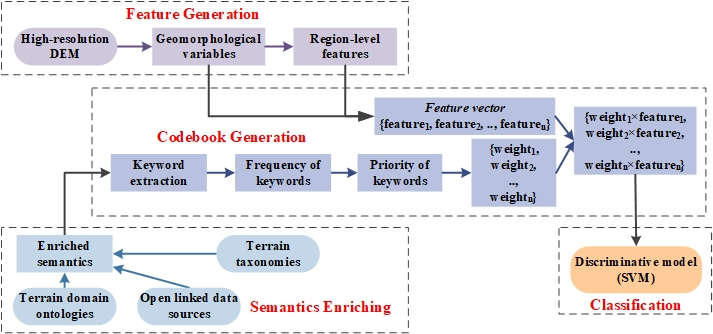【论文摘要】High-resolution digital elevation models (DEMs) and its derivatives (e.g., curvature, slope, aspect) offer a great possibility of representing the details of Earth’s surface in three-dimensional space. Previous research investigations concerning geomorphological variables and region-level features alone cannot precisely characterize the main structure of landforms. However, these geomorphological variables are not sufficient to represent a complex landform object’s whole structure from a high-resolution DEM. Moreover, the amount of the DEM dataset is limited, including the landform object. Considering the challenges above, this paper reports an integrated model called the bag of geomorphological words (BoGW), enabling automatic landform recognition via integrating point and linear geomorphological variables, region-based features (e.g., shape, texture), and high-level landform descriptions. First, BoGW semantically characterizes the composition of geomorphological variables and meaningful parcels of each type of landform. Based on a landform’s semantics, the proposed method then integrates geomorphological variables and region-level features (e.g., shape, texture) to create the feature vector for the landform. Finally, BoGW classifies a region derived from high-resolution DEM into a predefined type of landform by the feature vector. The experimental results on crater and cirque detection indicated that the proposed BoGW could support landform object recognition from high-resolution DEMs.
【论文信息】Xiran Zhou, Xiao Xie*, Yong Xue, Bing Xue, Kai Qin and Weijiang Dai. Bag of Geomorphological Words: A Framework for Integrating Terrain Features and Semantics to Support Landform Object Recognition from High-Resolution Digital Elevation Models[J]. ISPRS International Journal of Geo-Information. 2020, 9, 620; doi:10.3390/ijgi9110620


